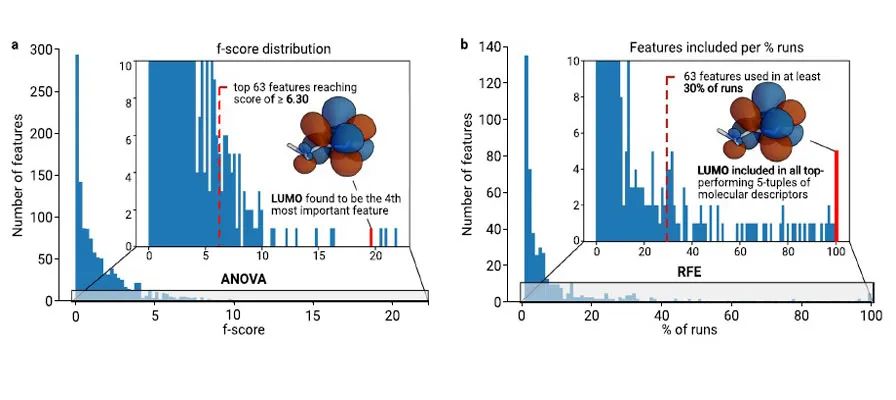Mg是地球上最丰富的元素之一,因其具有相对较高的电化学反应活性,发挥Mg的全部潜力的关键是控制材料的表面反应性,这可能为其诸多潜在应用领域带来独特的挑战:在运输应用(如航天、汽车等)中需要防止腐蚀,以确保材料的完整性;在医疗应用(如临时的、可生物降解的骨植入物)中需要根据病人的具体损伤来确定降解速度,以支持病人的恢复;在电池的镁负极应用中需要稳定的溶解速率以保持恒定的输出电压。小分子的有机物在控制这些应用领域的腐蚀方面表现出巨大的潜力,但目前仅靠高通量技术实验方法筛选潜在的小分子的有机物仍无法全面探索小分子的巨大化合物空间。因此,利用数据驱动的计算方法是否有可能更快更有效地搜索并筛选出各种具有可调缓蚀Mg离子的有机分子,非常值得探索。
由德国亥姆霍兹中心材料系统建模研究所的Roland C. Aydin教授和表面科学研究所的Christian Feiler教授领导的团队发现,稀疏特征选择方法可以帮助识别那些携带最有价值的分子描述符,以用于预测有机小分子对镁合金降解的缓蚀速率。除了经典的结构描述符,直接从DFT计算中导出的描述符也有一定作用,可作为备用方法。有趣的是,备用特征选择的方法揭示,化学高级模板搜索(CATS)的描述符具有巨大的应用潜力,如应用于人工智能驱动的药物发现。作者的研究表明,编码的药效基团特性也有助于描述有机小分子与金属离子(如Mg2+和Fe2+/3+)形成配合物的能力。在某些情况下,DFT衍生的描述符LUMO似乎作用重大,个体和群体特征选择的结果也证实了这一结论。对于小样本数据集,作者展示了自动编码器检测数据集中潜在的卓越能力。不过,作者开发的特殊处理方法很可能仅是大幅提高数据驱动的预测缓蚀速率的重要的第一步,只是为未来进一步研究开辟了一条充满希望的道路。
该文近期发表于npj Computational Materials 7: 193 (2021),英文标题与摘要如下,点击“阅读原文”可以自由获取论文PDF。
链接地址: https://www.nature.com/articles/s41524-021-00658-7#Sec7

Predicting the inhibition efficiencies of magnesium dissolution modulators using sparse machine learning models
Elisabeth J. Schiessler, Tim Würger, Sviatlana V. Lamaka, Robert H. Mei?ner, Christian J. Cyron, Mikhail L. Zheludkevich, Christian Feiler & Roland C. Aydin
The degradation behaviour of magnesium and its alloys can be tuned by small organic molecules. However, an automatic identification of effective organic additives within the vast chemical space of potential compounds needs sophisticated tools. Herein, we propose two systematic approaches of sparse feature selection for identifying molecular descriptors that are most relevant for the corrosion inhibition efficiency of chemical compounds. One is based on the classical statistical tool of analysis of variance, the other one based on random forests. We demonstrate how both can—when combined with deep neural networks—help to predict the corrosion inhibition efficiencies of chemical compounds for the magnesium alloy ZE41. In particular, we demonstrate that this framework outperforms predictions relying on a random selection of molecular descriptors. Finally, we point out how autoencoders could be used in the future to enable even more accurate automated predictions of corrosion inhibition efficiencies.
![]()
免责声明:本网站所转载的文字、图片与视频资料版权归原创作者所有,如果涉及侵权,请第一时间联系本网删除。

官方微信
《腐蚀与防护网电子期刊》征订启事
- 投稿联系:编辑部
- 电话:010-62316606-806
- 邮箱:fsfhzy666@163.com
- 腐蚀与防护网官方QQ群:140808414





